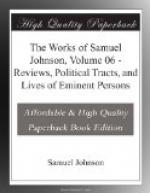It has now been fashionable, for near half a century, to defame and vilify the house of Stuart, and to exalt and magnify the reign of Elizabeth. The Stuarts have found few apologists, for the dead cannot pay for praise; and who will, without reward, oppose the tide of popularity? yet there remains, still, among us, not wholly extinguished, a zeal for truth, a desire of establishing right, in opposition to fashion. The author, whose work is now before as, has attempted a vindication of Mary of Scotland, whose name has, for some years, been generally resigned to infamy, and who has been considered, as the murderer of her husband, and condemned by her own letters.
Of these letters, the author of this vindication confesses the importance to be such, that, “if they be genuine, the queen was guilty; and, if they be spurious, she was innocent.” He has, therefore, undertaken to prove them spurious, and divided his treatise into six parts.
In the first is contained the history of the letters from their discovery by the earl of Morton, their being produced against queen Mary, and their several appearances in England, before queen Elizabeth and her commissioners, until they were finally delivered back again to the earl of Morton.
The second contains a short abstract of Mr. Goodall’s arguments for proving the letters to be spurious and forged; and of Dr. Robertson and Mr. Hume’s objections, by way of answer to Mr. Goodall, with critical observations on these authors.
The third contains an examination of the arguments of Dr. Robertson and Mr. Hume, in support of the authenticity of the letters.
The fourth contains an examination of the confession of Nicholas Hubert, commonly called French Paris, with observations, showing the same to be a forgery.
The fifth contains a short recapitulation, or summary, of the arguments on both sides of the question.
The last is an historical collection of the direct or positive evidence still on record, tending to show what part the earls of Murray and Morton, and secretary Lethington, had in the murder of the lord Darnley.
The author apologizes for the length of this book, by observing, that it necessarily comprises a great number of particulars, which could not easily be contracted: the same plea may be made for the imperfection of our extract, which will naturally fall below the force of the book, because we can only select parts of that evidence, which owes its strength to its concatenation, and which will be weakened, whenever it is disjoined.
The account of the seizure of these controverted letters is thus given by the queen’s enemies.
“That in the castell of Edinburgh, thair was left be the erle of Bothwell, before his fleeing away, and was send for be ane George Dalgleish, his servand, who was taken be the erle of Mortoun, ane small gylt coffer, not fully ane fute lang, garnisht in sindrie places with the roman letter F. under ane king’s crowne; wharin were certane letteris and writings weel knawin, and be aithis to be affirmit to have been written with the quene of Scottis awn hand to the erle.”




